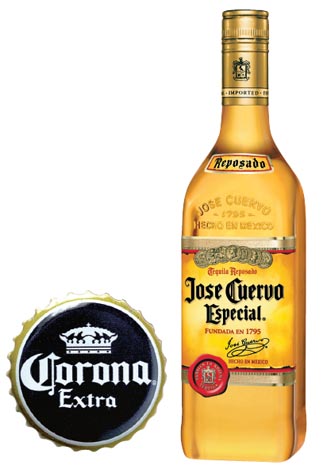Upgrading trade with Mexico

Some of Mexico’s most recognized exports to Korea are alcoholic beverages including Corona beer and Jose Cuervo, the No. 1 tequila in Korea. Provided by JoongAng Ilbo, Pernod Ricard Korea
To this day, the deal that’s had the most impact on the Mexican economy is the North American Free Trade Agreement signed by the United States, Canada and Mexico, which came into effect in 1994.
A similar trade deal with Korea, however, is still in the works. In September 2005, former President Roh Moo-hyun visited Mexico and agreed to go forward with a bilateral trade agreement called the Strategic Economic Complementation Agreement, or SECA. Compared to a full FTA, which makes trade liberalization possible on a broader scale, the SECA lowers tariffs on select sectors.
However, as trade talks stagnated, the two countries decided to negotiate instead for a full free trade agreement in 2007. Last month Korean Foreign Minister Yu Myung-hwan met with his Mexican counterparts to discuss the possibility of pushing the Korea-Mexico FTA forward. The deal has been stalled mainly due to opposition from Mexico’s manufacturing sector, in particular from automakers.
The trade volume between Korea and Mexico has climbed since the late 1990s and by 1999, Mexico was Korea’s top exporting country among all Latin American nations, according to the Korea Trade-Investment Promotion Agency.
As of the first half of last year, Korea was the fourth largest importer to Mexico, following the United States, China and Japan. Imports from Korea last year took up around 5 percent of all imports to Mexico. Korean exports to Mexico have been on the rise since 2001, with a total $2.15 billion worth of products shipped to Mexico. By 2008, Korean exports to Mexico rose to around $9 billion - up 21.5 percent compared to 2007.
Top Korean items imported by Mexico include liquid-crystal devices, color TV parts and auto parts, according to the Korea International Trade Association. Hyundai Motor, for example, exports cars to Mexico in collaboration with Daimler AG, whose small-sized cars do well in the Mexican market.
Imports from Mexico to Korea are also rising gradually, totaling $105 million in 2008 - a 13.6 percent rise on-year.
Still, Mexico’s biggest export partners continue to be the United States, Canada and Germany. Mexico’s top export items include electrical equipment, raw materials, auto parts and machinery, according to the economy ministry in Mexico.
Some of the most recognized consumer product imports from Mexico in Korea are alcoholic beverages including tequila and beer brands such as Corona. Popular Mexican tequila brand Jose Cuervo, in fact, takes up more than 70 percent of Korea’s tequila market share, according to Pernod Ricard Korea, the company that imports the brand in Korea.
“Korea’s tequila market has been growing an average 15 percent yearly since 2000 and the unrivaled No.1 premium tequila in Korea is Jose Cuervo Especial,” said Yoo Ho-sung, public relations manager at Pernod Ricard Korea.
Lee Jong-seo, an employee for Mexican carrier AeroMexico operations in Korea, says that interest in Mexico among Asian countries is rapidly growing. “Although an exact number is hard to estimate, a maximum 10,000 Koreans visit Mexico per year,” he said.
Korean investment in Mexico has also been on the rise since Nafta.
“Since 1994’s Nafta, Mexico has become a key market for countries looking to invest in the North American market. Korean electronics companies looking to penetrate the U.S. market also began setting up operations in Mexico, benefiting from Mexico’s inexpensive labor costs,” a Kotra official said.
Korea’s biggest companies, including Samsung Electronics, LG Electronics and Posco, all have operations in Mexico. In particular, Samsung Electronics’ Mexican subsidiary, SEM, announced it will invest $120 million by 2013 to build a production line in Queretaro to manufacture the latest refrigerators. LG Electronics had invested $30 million by December 2008 and built a production line in Monterrey to make electric ovens.
Mexico experienced a double burden last year when, along with the aftermath of the global economic crisis, it also saw an outbreak of the H1N1 flu that affected the economy.
“With the H1N1 flu, Mexico’s unemployment rate soared, the cost of living rose rapidly and economic growth faltered,” Kotra said in a statement.
Mexico’s economy shrank 6.8 percent last year - the worst fall in around 30 years, according to the country’s treasury department.
Experts predict, however, that Mexico’s economy will recover starting this year. “Since the global economic crisis in 2008, Mexico’s main industries, including manufacturing and oil exports, have been down. We expect the country’s economic growth will start to recover in the first quarter of 2010,” said Kotra.
By Cho Jae-eun [jainnie@joongang.co.kr]










with the Korea JoongAng Daily
To write comments, please log in to one of the accounts.
Standards Board Policy (0/250자)